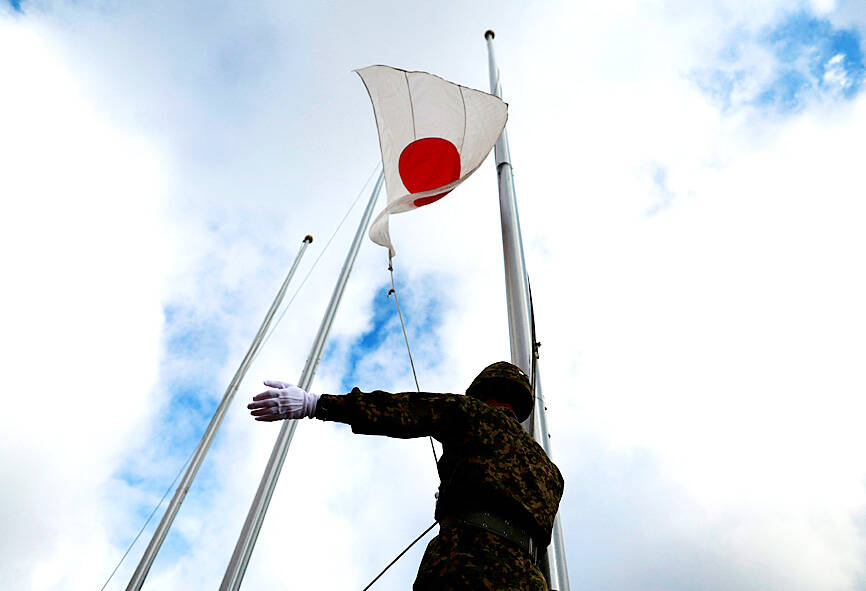The Japanese government is planning to build air defense shelters on Miyako Island in Okinawa Prefecture due to concerns that war might break out in the Taiwan Strait, Japanese media reported.
Japanese Chief Cabinet Secretary Hirokazu Matsuno on Saturday reportedly visited the prefecture to discuss evacuation plans in the event of such an emergency.
Japan would soon begin gathering opinions from experts to draw up guidelines for air defense shelters, so that they could withstand an attack by the end of the year, the Yomiuri Shimbun reported yesterday.

Photo: Reuters
About 10 experts would be selected to formulate the guidelines, the newspaper said, adding that standards for floor space and wall thickness are expected to be discussed with nuclear and missile attacks in mind.
Japan’s National Security Strategy, which was revised in December last year, states that Japan must strengthen its civil protection system and evacuation facilities, especially on the Nansei Islands, including Miyako Island, which is governed as part of the City of Miyakojima, the Yomiuri Shimbun said.
The aim is to ensure the safety of local government employees and others who would likely be unable to evacuate in advance, it said.
The Miyakojima city government last month asked the Japanese Ministry of Defense to provide financial assistance to convert the basement of a planned gymnasium into an air defense shelter, the newspaper said.
Equipped with storage warehouses and power generation facilities, the shelter has been designed to accommodate about 4,500 people for three days, it said.
In addition to Miyako Island, Japan would expedite efforts to build air defense shelters on the islands of Yonaguni and Ishigaki, it said.
Yonaguni Island, also part of the Nansei Islands, is about 100km from Taiwan and is likely to be affected if China invades Taiwan, the Yomiuri Shimbun said.
Meanwhile, Matsuno on Saturday began a three-day visit to the Nansei Islands to learn about “the situation and opinions on the ground” while devising plans to protect Japanese nationals during a Taiwan emergency, Japanese public broadcaster NHK reported on Saturday.
It could take up to 10 days to evacuate everyone on Ishigaki Island, including tourists, so shelters would be needed to ensure their safety, Matsuno was quoted as saying.
Ishigaki Mayor Yoshitaka Nakayama said he hoped the central government could help expand the isalnd’s quays and extend its airport runways to ensure quick evacuations during emergencies, NHK reported.

A Chinese aircraft carrier group entered Japan’s economic waters over the weekend, before exiting to conduct drills involving fighter jets, the Japanese Ministry of Defense said yesterday. The Liaoning aircraft carrier, two missile destroyers and one fast combat supply ship sailed about 300km southwest of Japan’s easternmost island of Minamitori on Saturday, a ministry statement said. It was the first time a Chinese aircraft carrier had entered that part of Japan’s exclusive economic zone (EEZ), a ministry spokesman said. “We think the Chinese military is trying to improve its operational capability and ability to conduct operations in distant areas,” the spokesman said. China’s growing

Nine retired generals from Taiwan, Japan and the US have been invited to participate in a tabletop exercise hosted by the Taipei School of Economics and Political Science Foundation tomorrow and Wednesday that simulates a potential Chinese invasion of Taiwan in 2030, the foundation said yesterday. The five retired Taiwanese generals would include retired admiral Lee Hsi-min (李喜明), joined by retired US Navy admiral Michael Mullen and former chief of staff of the Japan Self-Defense Forces general Shigeru Iwasaki, it said. The simulation aims to offer strategic insights into regional security and peace in the Taiwan Strait, it added. Foundation chair Huang Huang-hsiung

PUBLIC WARNING: The two students had been tricked into going to Hong Kong for a ‘high-paying’ job, which sent them to a scam center in Cambodia Police warned the public not to trust job advertisements touting high pay abroad following the return of two college students over the weekend who had been trafficked and forced to work at a cyberscam center in Cambodia. The two victims, surnamed Lee (李), 18, and Lin (林), 19, were interviewed by police after landing in Taiwan on Saturday. Taichung’s Chingshui Police Precinct said in a statement yesterday that the two students are good friends, and Lin had suspended her studies after seeing the ad promising good pay to work in Hong Kong. Lee’s grandfather on Thursday reported to police that Lee had sent

BUILDUP: US General Dan Caine said Chinese military maneuvers are not routine exercises, but instead are ‘rehearsals for a forced unification’ with Taiwan China poses an increasingly aggressive threat to the US and deterring Beijing is the Pentagon’s top regional priority amid its rapid military buildup and invasion drills near Taiwan, US Secretary of Defense Pete Hegseth said on Tuesday. “Our pacing threat is communist China,” Hegseth told the US House of Representatives Appropriations Subcommittee on Defense during an oversight hearing with US General Dan Caine, chairman of the Joint Chiefs of Staff. “Beijing is preparing for war in the Indo-Pacific as part of its broader strategy to dominate that region and then the world,” Hegseth said, adding that if it succeeds, it could derail